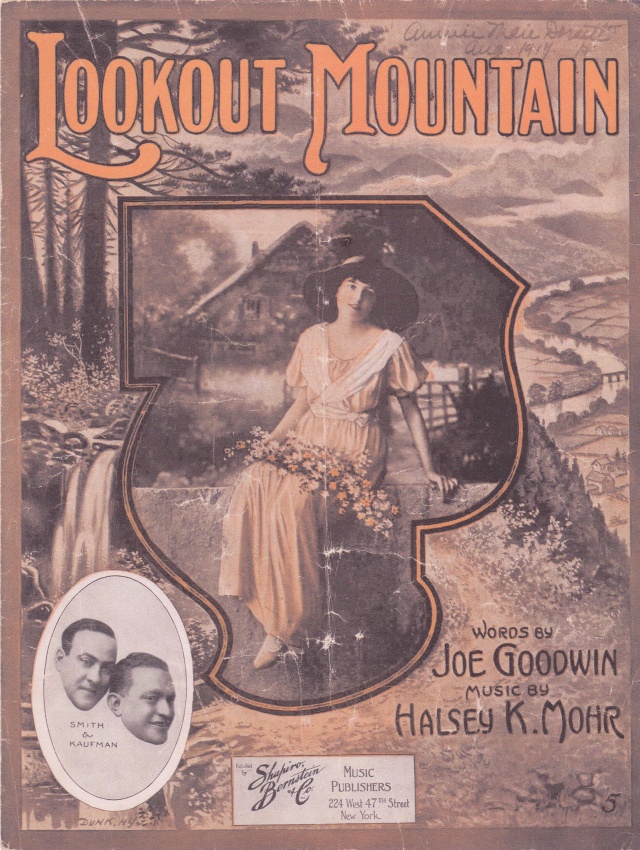
Cover, sheet music to the song “Lookout Mountain,” by Goodwin & Mohr; Robert C. Hansen Performing Arts Collection, 1753-2006 (MSS255), Martha Blakeney Hodges Special Collections and University Archives and Manuscripts, University of North Carolina at Greensboro, NC, USA.
I am reaching across that invisible Georgia – Tennessee state line again. Although there are many Georgia photographers with roots in all parts of the state of Tennessee, my two-part post, A Mountain of Connections, highlights Georgia photographers with Chattanooga-area connections. There are those photographers who worked in the nearby Dalton and Rome, Georgia areas to discuss, and there are Chattanooga photographers to tell you about who either came to or advertised in Georgia in attempts to attract patrons to come “up” to their studios.
In the same way a book I read urged me to finalize Part One, I was urged to post this second part by a serendipitous reading. This time it was the beautiful book of photographs entitled Rock City Barns: A Passing Era, which I purchased at my local library. Written by photographer-writer David B. Jenkins, and now out of print, it is based on the work of sign-painter Clark Byers as documented in the records of the See Rock City tourist attraction (Lookout Mountain, GA). Byers was a young man when, in about 1937, he began painting Rock City advertisements, with owners’ permission, on barns across the country.
Byers and his crew continued painting the “See Rock City” ads on barns for thirty years. He built a home near Rising Fawn, Georgia in 1947 (and painted See Rock City on the roof!), and he continued his traveling and painting until accidentally electrocuted in 1968. The resulting hospitalization forced his retirement. Byers is also responsible for the red/black birdhouses still used for advertising Rock City.
David Jenkins was able to document at least twenty barns not found in Rock City company files. He visited over 500 sites in fifteen states, in eighteen months, covering about 35,000-miles as he documented the then remaining barns. There were once about 900 of them, stretching from Florida to Canada and from the Carolinas to Texas. By 1996 there were 260 and only 85 of those were still maintained by the Company. There are far fewer left today, but you can see some here.
The book contains at least one color photograph for each state. For Georgia, there are twelve color photos of barns, in an equal number of Georgia counties. Those barns that could not be reproduced in color are included in the back of the book in smaller black and white photos. In this section there are another twenty-four Georgia barns in eighteen Georgia counties. No matter which state interests you, look at the lovely photographs in this book – and notice how many barns in your state no longer exist.
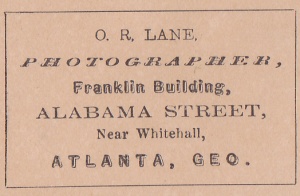
Detail of O. R. Lane carte de visite back, Atlanta, ca. 1867; author’s collection
One photographer who made his way to Georgia from Tennessee is O. R. [Owen Rudolph] Lane (1834-1912). He was born in Tennessee, possibly in the Nashville area where he was living with his family in 1850. He married in 1858, and by 1860 he was clerking in Nashville.
Lane served in a Tennessee cavalry unit during the Civil War, and he came to Atlanta and opened a studio about a year after the close of that war. The first Atlanta advertisement I have found for him is in early April 1866 (Daily Intelligencer, April 5, 1866 page 3). This supposed “editor’s note” mentions Lane “had several year’s experience as a Photographer [and] a practical chemist.” Lane continued in business in Atlanta, certainly through 1900 and possibly into 1910, perhaps about forty years.
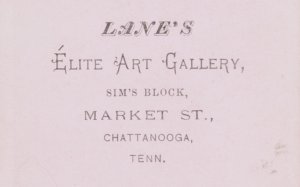
Detail of O. R. Lane’s Elite Art Gallery carte de visite back, Chattanooga TN ca. 1877; from Likenesses Within the Reach of All, The University of Alabama, [accessed Aug. 9, 2016], https://apps.lib.ua.edu/blogs/cdv/
According to Chattanooga city directories, Lane ran his studio in that city under various names (as he did in Atlanta), from 1876 into 1887. In the South, you can find Lane’s Chattanooga photographs in the collections of the University of Alabama (Southern Carte de Visite Collection, A.S. Williams III Americana Collection, Department of Special Collections), in the University of Tennessee’s 19th Century Tennessee Photographers Collection (MS-2511), and at the University of Texas Harry Ransom Center.
In Atlanta, Lane employed artist Joe Bethel as his colorist by March 1867. Bethel had previously worked for A. J. Riddle in Macon, Georgia. According to Lane’s advertisements, Joe Bethel was his “eminent young artist” who “beautifully painted” Lane’s photographs.
Bethel left Lane’s employ sometime before June 1867. After working somewhere in “Southern Georgia,” in about September 1867, he traveled through Atlanta on his way to a new job in Chattanooga, Tennessee (Atlanta Daily Intelligencer September 1, 1867, p. 3 c.1); at this point I lost track of Mr. Bethel.
Lane carried on without him, and a few months later, according to the Atlanta Daily Intelligencer (August 15, 1867 p3), he employed a colorist who was an unnamed
accomplished lady, who –possesses genius of a high order in the coloring of pictures. .
Artist Joseph H. Van Stavoren (1818-1893) worked for Lane as his colorist in 1871-72. Van Stavoren had previously worked in Tennessee and may have known Lane there. It is quite possible that Lane trained as a photographer with Van Stavoren in Nashville.
Although J. H. Van Stavoren spent much of his career as an artist, he was an established photographer in Nashville from at least 1864, before coming to Atlanta sometime in 1871. A future post of mine on Mr. Van Stavoren will tell you about this man’s fascinating career, as well as about his photographer son, James.
O. R. Lane made the Atlanta newspapers more than once. The same August 1867 newspaper article mentioning his “lady colorist” had a glowing review of Lane’s photographs which
by far eclipse anything of the kind ever before produced in this city, and fully equaling the best pictures taken at some of the famous galleries in New York.
This provoked a response from F. [Franklin, “Frank”] Kuhn (1829-1908) of the Pioneer Gallery. He took issue with “the gratuitous remark” that Lane’s photographs are better than any other (Atlanta Daily Intelligencer, August 18, 1867 p.2). In late June 1871, Lane a got into an argument in the Kimball House billiard room with photographer Merton Smith, who was now the partner of F. Kuhn (as Kuhn & Smith). An “unpleasantness arose,” involving spitting and cursing. This new argument began when Lane was forced to pay a fine of $50.00 for working on Sunday. Kuhn & Smith immediately placed an advertisement in the Atlanta newspapers asking citizens to
compare our work with that of other establishments, and you will at once see the difference. No picture made at our Rooms on the Sabbath. We leave that to common operators–$50 and costs.
Both the Atlanta and Macon newspapers followed the feud, and letters from each side were printed until the episode finally ran its course. (Atlanta Daily Sun June 30, 1871 p.3 c.5; Macon Telegraph July 4, 1871 p.1; Atlanta Weekly Sun July 5, 1871 p.2 c.4)
O. R. Lane was known as “Professor” Lane for most of his working life in Atlanta and in Chattanooga. This was due in no small part to his self-promotion on the reverse of some of his carte de visite, such as
Inventor and Patentee of Lane’s Eclipse Ivorytype. These pictures attract universal admiration and acknowledged by all who see them to be the greatest triumph in the Art of Photography.
On some of his cartes backs Lane also listed the “New Styles Cartes de Visites” [sic], all beginning with “Lane’s,” including Lane’s Pearlletta, Lane’s Sun Beam, and Lane’s Ivory Beauties. According to his December 11, 1919 (Atlanta Constitution p.2) obituary, he was
widely known as an inventor, photographer, and chemist…….For some time Professor Lane had been interested in the invention of a flying machine.
J. H. Van Stavoren’s work as a photographer in Nashville overlapped that of another photographer, T. [Theodore] M. Schleier, who was working there from 1865 to 1866. Perhaps due to this competition, Schleier left Nashville for Knoxville, where he worked from 1869 through 1876. He moved his studio to Chattanooga in 1877, and he worked as a photographer there for two years.
T. M. Schleier (1832 – ca. 1905) advertised his Knoxville photo studio in the Dalton, Georgia North Georgia Citizen from October 1874 into September 1876, and then his Chattanooga “Fine Art Gallery (and Dealer in Photograph and Ferrotype Materials)” in the North Georgia Citizen from early July 1878 into September 1879. His two full-page advertisements in the 1878-79 Chattanooga city directory are quite impressive. One of the two, not reproduced here, used real photographs; Schleier cautioned readers not to remove them from the book, and copies could be obtained at his studio.
Schleier returned to Nashville in 1880 and worked there eight years. J. H. Van Stavoren was working in Atlanta by that time and he was no longer a competitor. By 1897 Schleier was working as an artist in Bridgeport, Connecticut, and by 1900 he was in New York City, working again as a photographer.
Another Georgia-related photographer who came to Chattanooga before the turn-of-the-century is M. [Marcus] E. [Elias] Schmedling (1853-1912). He possibly arrived here from Norway as early as 1880 (biographical information Preus Museum Photographer Register, National Library, Norway).According to city directories, he was working in St. Louis, Missouri as a photographer with the Hulbert Bros., by 1883. In late November 1885 he was in Galveston, Texas as a partner to photographer Philip H. Rose, as Rose & Schmedling. He left there sometime in 1887 or early 1888 – we know that in 1888 he was in Chattanooga in his Gallery on Market Street.
It is interesting that in 1889, only the second year he was in Chattanooga, he was not listed in the city directory at all. The “Schmedling Studio” was instead run by Edward W. Comfort, who was listed as proprietor. It is possible that Schmedling left the studio in other hands and traveled home to Norway for a visit. In the cabinet card below, photographer Schmedling seems to suggest a Norwegian winter scene.
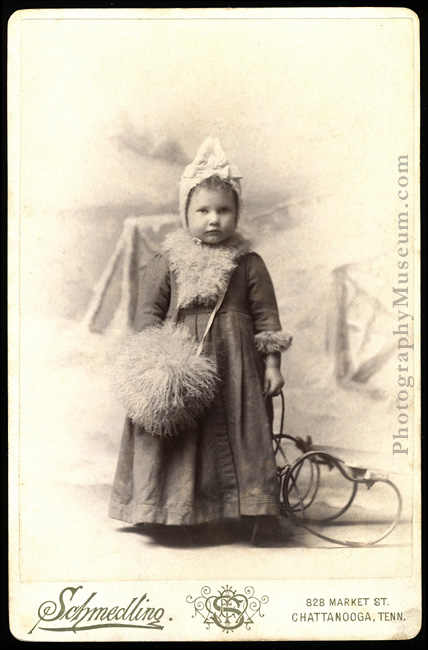
Studio portrait of an unidentified girl, cabinet card by M. E. Schmedling, ca. 1890; courtesy Wm. B. Becker Collection / American Museum of Photography http://www.photographymuseum.com
Although he worked there only about ten years (1888-1897), Schmedling became one of the better known of Chattanooga area photographers. Many photographs, in family collections as well as in libraries, archives, and museums, bear his photo mark.
On June 9, 1895, an article appeared in the [Chicago] Inter-Ocean, entitled “Chickamauga Park.” Various cuts were used to illustrate the article and among them was:
This old photograph was recently discovered, and developed by Schmedling, a Chattanooga photographer, and in the cut herewith given —- [one] can pick out General Grant standing to the left…..

Illustration used in “Chickamauga Park,” article by G. Edmund Hatcher, [Chicago] Inter-Ocean June 9, 1895 p.29.
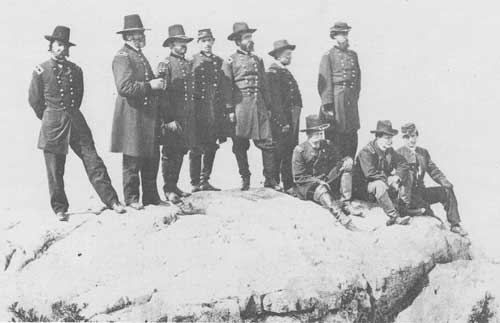
General Thomas and staff, Lookout Mountain, 1863; LC photograph used in the National Park Service’s Civil War Series: The Battles for Chattanooga
According to my findings, the photograph was misidentified in the article. The person noted as General Grant is actually General Thomas. Going from left to right – General J.H. King, Gen. Thomas, Gen. Tower, Gen. Donaldson, Gen. Brannon, Dr. Cooper, Engineer Merrill, Gen. Whipple, Lt. Kelly, and Lt. Kellogg.
After leaving Chattanooga, M. E. Schmedling worked for a short time in Ringold, Georgia, just across the state line. He paid a photographer’s tax in Catoosa County, Georgia in 1898, the same year he returned to Galveston, Texas, to re-partner with P.H. Rose for another year.
In about 1900, Schmedling returned to Norway where he was known as a photographer and bookbinder. He built a house there he called “Lokaut,” no doubt to remind himself of the beautiful Lookout Mountain area in which he once lived.
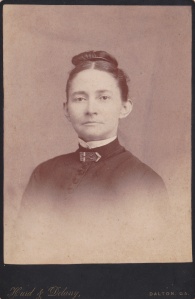
Portrait of an unidentified woman, cabinet card by Hurd & Delany, Dalton, GA, ca. 1888; collection of E. Lee Eltzroth
In the small city of Dalton, Georgia, two “Yankee” photographers, E. [Edgar “Ed”] O. [Osgood] Hurd (1858-1934) originally from Boston, Massachusetts, and C. [Charles] M. Delaney (1858-1933) originally from Wisconsin, were in partnership as Hurd & Delany by 1885.
According to census records both these men were living in Racine, Wisconsin in 1880. C. M. Delany is listed as a photographer in the 1882 Racine city directory. Although E. O. Hurd is not listed, it is possible he worked in Delany’s studio.
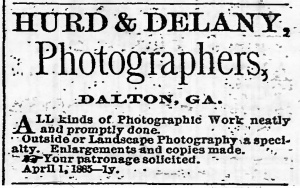
This Advertisement for Hurd & Delany appeared in the [Dalton] North Georgia Citizen from April 1885 into April 1886
will be at their gallery in person from Feb. 17th for one month, — the very fine work they do has gained them fame in Chattanooga.
Chattanooga city directories list them as partners from 1890 to 1892, and the Southern Business Directory lists them in Chattanooga in 1893 and 1894. According to city directories, Delany was working alone there in 1894, and was working for Hurd, who had returned, in 1895. Both had left Chattanooga by 1896. Their Chattanooga photographs are found in the same three significant southern collections as are O.R. Lane’s (as mentioned above).
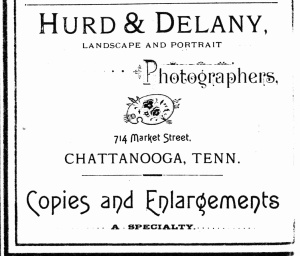
Advertisement for Hurd & Delany, 1891 Chattanooga city directory, p. 75
E. O. Hurd was back in Boston as a photographer by 1899, according to Boston city directories. Hurd had returned to Boston even while working in Dalton. He was there as a tenor with the “celebrated Boston concert company” in 1886 (North Georgia Citizen Feb. 4, p.3 c.2 and April 29, 1886 p.3 c.2). He was later described as the
possessor of an exceedingly mellow and sympathetic tenor voice —- for a number of years he was a valued member of the Episcopal choir in Racine Wis., and Chattanooga, Tenn. (North Georgia Citizen May 9, 1920 p.23).

Detail of Edgar O. Hurd’s Forsyth, Georgia imprint on a photograph mat, ca. 1910
By 1900 C. M. Delany was working in Montgomery, Alabama as photographer. He was listed in city directories and in census records there through 1930, and he died there in the spring of 1933.
Edgar O. Hurd left Boston around 1904, and moved to Forsyth, Georgia, where he worked as a photographer for over fifteen years. He stayed in Georgia until about 1922.
In May 1920 Hurd traveled from Forsyth, Georgia, to Montgomery, Alabama, to visit his old partner Delany. The visit was mentioned in the same article cited directly above which noted Hurd’s singing abilities. They also wrote that Hurd
is an artist-photographer [and] has won first prize for the best portraits several years running at the Southern Photographers Convention.
By 1923, E. O. Hurd was living in Los Angeles County, California, and was no longer a photograph. He died in California in 1934.

Photographer W [William, “Willis” “Will”] H [Henry] Wilson (1851-1922) was born in Tennessee, had a farm in the Dalton, Georgia area by 1880, and was a photographer there by about 1890. As far as I can determine, he never worked as a photographer in Chattanooga, but he was quite aware of the draw of his potential customers to that city.
An advertisement he posted (above) in Dalton’s North Georgia Citizen on June 10, 1895 (p.3. c.1) insures Daltonians that his work is better than Chattanooga “in price and quality.” Wilson worked as a photographer in Dalton until about 1908, and from 1901 to 1902 he he employed at least one artist, Dalton-born Lucile Trotter (1871-1913). A former art teacher, Trotter married in 1903, and moved with her husband to Chattanooga, where she is buried.
W. H. Wilson became a retail merchant in Dalton before 1910. By 1920 he and his wife and younger children were living in Atlanta, where he owned a grocery store. He died in 1922 and is buried in Atlanta. His son, John Chappell “Chap” Wilson (1873-1951), who had worked with his father since 1893, took over the Wilson photography business in Dalton in about 1908, and remained a photographer there until about 1950.
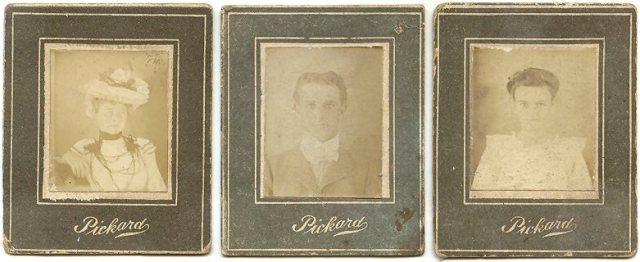
Three Pickard Penny Photographs, approximately 2 1/4″ x 2 3/4″, Rome, GA ca. 1902; collection of E. Lee Eltzroth
Pickard’s Penny Photographs were being sold in the Rome, Georgia and Chattanooga, Tennessee area from about 1900 to 1903. The “penny” photos (approx. 2 1/4″ x 2 3/4″ mounted) in my possession are marked either with the name of both cities, or marked with “Chattanooga” only.

Backmark detail on a Pickard Penny Photograph, Rome, GA and Chattanooga, TN about 1902, note spelling error; author’s collection
Pickard’s, or their company, were at one time headquartered in Philadelphia. They reportedly worked in Phoenixville, Pennsylvania, near Philadelphia, about 1885, and in Shelbyville, Indiana about 1895. They are also noted in Philadelphia, about 1905. They were in Stapleton, Staten Island, New York in about 1912, where they photographed photographer, Alice Austin and a friend. They were also in Amboy, Hoboken, and Burlington, New Jersey in about 1915.
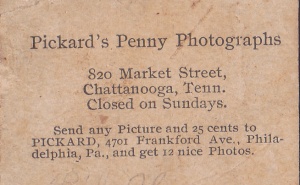
Backmark detail on a Pickard’s Penny Photograph, Chattanooga TN, ca. 1903; author’s collection
Jasper S. Pickard (b. ca. 1875 in Texas) ran Pickard’s Penny Photo Gallery in Winston, North Carolina, assisted by his daughter Lena, by 1904. They worked in that city until about 1908 (1904-1905 Winston-Salem city directory; Stephen E. Massengill, compiler, Photographers in North Carolina, p. 163).
Although there were other photographers with the surname of Pickard, it is possible that this particular Pickard and his daughter in North Carolina had worked just prior to that time in Tennessee and Georgia. Pickard’s definitely had African American customers in North Carolina (many are for sale online), and I assume they had customers of both races also in Georgia and/or Tennessee.
A few other photographers offered “Penny Photos” in north Georgia, one at about the same time that Pickard’s did. The Southern Penny Photo Co. in Gainesville, Georgia, run by Miss Frances C. Pfeffer, specialized in them from 1901 through 1904. Dalton photographer J. C. Wilson, mentioned earlier, sold them in 1910 because
so many of my customers have asked me to make penny or stamped photos, I have decided to do so for a short time and will make them 24 for 25 cents. (N. Georgia Citizen Aug. 23, 1910 p.2 c.7)
Thank you for getting through my lengthy Part Two post! I hope something in it interests you or provokes your curiosity. A penny (photograph?) for your thoughts: your Comments to the post are always welcome. Feel free to contact me for more detailed information or sources, or with any questions. For these remaining days of summer, I wish you the very best of luck in your own Hunting and Gathering.
© E. Lee Eltzroth and Hunting & Gathering, 2016. Unauthorized use and/or duplication of this material without written permission from this blog’s author is prohibited. The piece can be re-blogged, and excerpts and links may be used, provided that full and clear credit is given to E. Lee Eltzroth and Hunting & Gathering, with appropriate and specific direction to the original content.
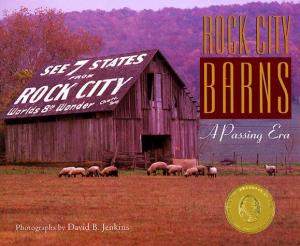
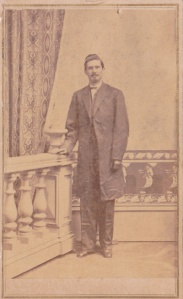

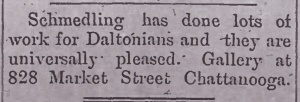
Thanks immensely for the GA-TN connection. What riches. Photographers did not pay much attention to state lines, did they? Just went where the work might be. This is an exemplary post, and I can’t thank you enough.
Frances
Thank you, as always Frances, for reading! What a nice thing to say, I really do appreciate it.
I am the GGreatgrandson of Joseph Van Stavoren and am very interested in what you know about him. Tou mentioned a future post about him but I can’t seem to find it.
Hi, no I haven’t gotten back to him and I am sorry. I am posting later this week for the first time in a few months, but on Van Stavoren. Let me send you my data on him from my database and you let me know what I lack.
I purchased a photo of Mrs Collins by W H Wilson which is strikingly beautiful. Is there a way I can send you a scan of it? Thanks for the information on the photographer.
I would love to see it! I will email you. Thanks.
I have a photo marked M. E. Schmedling in Gainesville, FL. I can’t identify the woman in the picture and can’t seem to find Schmedling in FL. Did he have a studio in Gainesville? If so, do you know when?
Thanks for your help.
Kathy Fowler
I believe that would be Gainesville, GA instead of FL. Schmedling worked in some north Georgia cities, but I have not run across him in Florida yet! I will contact you so you can send me a digital photo of the mark if you believe it is indeed FL.
Hi Kathy! I work at the Matheson History Museum in Gainesville, Florida and we also have a photograph taken at the M.E. Schmedling Art Gallery and it does say it was in Gainesville, Florida. I would love to see the photograph you have, I’ve been trying to determine what years he worked here. There’s a chance we could help you identify the woman in your photograph as we do have quite a few 19th century portraits of Gainesville locals in our collection!
I see he likely did have a studio in Gainesville FL — I will get back to you when I know more.
SO GRATEFUL you included W. H. Wilson of Dalton, GA in this article. Have some unidentified family photos — some of them from Wilson’s studio. I have copies of a few photos made by W. H. Wilson in Dalton, GA. The originals were in the possession of Dr. Ray Hooper of Corpus Christi, TX. They are of likely family members of the Hooper/Hames/Gilbert family lines who were in neighboring Murray and Gordon Co., GA, although the Hames family, excepting a daughter who married a Hooper, had moved on to Bonner Springs, KS before W. H. Wilson apparently opened his studio in Dalton. Two Hooper families went on to KS; my great-grandmother returned to GA/TN. Another of the Hooper’s went on down to TX. Have some copies of photos made by a Bonner Springs, KS photographer. Most unidentified. . . . Sigh.
Thanks for reading! W. H. Wilson is an interesting photographer and I know he briefly did some work in Elijay (1898) and Dawsonville (1906), and died in Atlanta in 1922 — I expect to find more on him, so stay tuned! You may get the identification on those family photographs.
I bought a portait of a young Civil War era lady with the backmark of J. H. Van Stavoren’s Metropolitan Gallery, 53 College St. Nashville. There isn’t a stamp on the back,
Hi, I can tell you that J H Van Stavoren (1818-1893) worked in Nashville TN 1864-ca. 1975, and is on the 1860 (Maury County) & 1870 (Davison/ Nashville) TN census. His first visit to Atlanta was in 1871-72, and he moved there by 1877. In Nashville he was well-known for his Solar Camera. His Metropolitan Photograph and Picture Gallery was at 53 College St.by Jan. 1864. He later moved to corner Cherry & Union streets. Check the city directories to find out when he changed locations and you should have a more accurate date on your image. Good Luck!
The UT Knoxville 19th Century collections hold some of his work, as do other repositories.
Thanks, enjoyed your article. I have a photo that came from my grandmother’s estate. It is stamped “Pickard’s Penny Photographs South Side Public Square Winston, N. C.
Pickard’s really got around, didn’t they? I own some made in Rome GA and in Chattanooga TN but they seem to have gotten all over the South, likely selling what we would call franchises and putting a photographer in charge in each place. I have noted them also in PA, NJ, and AL